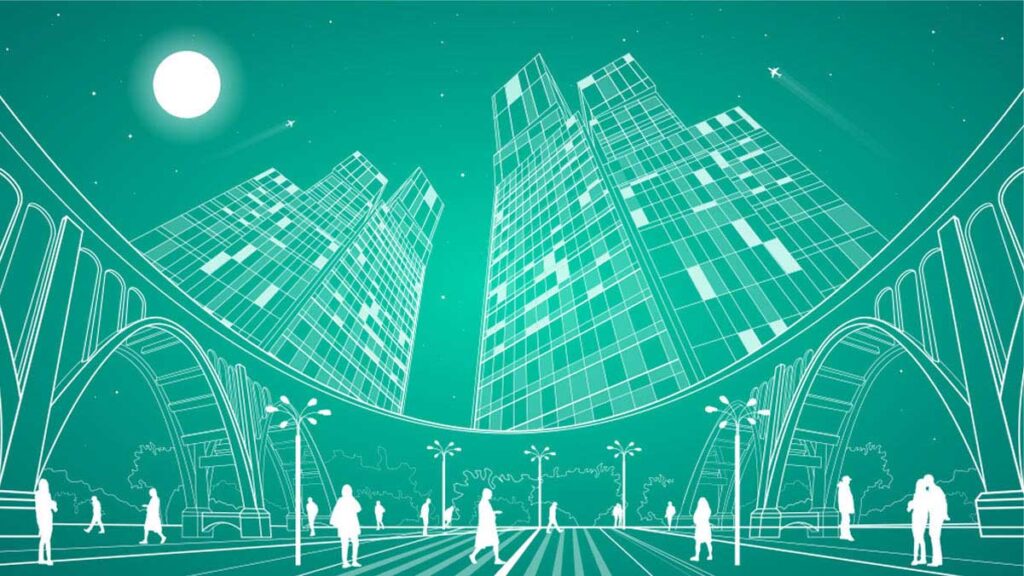
Planet Earth, a captivating and bountiful big blue marble, roaming in space. A Terra we call home. Yet, as humans, we tend to have detrimental and catastrophic environmental effects in ways exceeding expectations on our homeland. Effects that elicited disastrous climate issues and urbanization are one of them. This issue prompted the creation of intelligent metropolises through the implementation of smart cities sustainable technologies.
Before we indulge in the role a sustainable smart city can play to halt the development of an extensive list of dire climate challenges, I must first answer one essential question, which I am sure you are asking yourself. “What do you mean by smart city?”
Smart City Sustainability
The hasty progression of technology and the welcoming embrace of digital transformation on all fronts has left cities and their citizens with a thirsty craving to be more connected through innovation. In the past decade, technology played a critical and evident part in being the correct answer to numerous questions circulating from citizens and governments. One significant question being asked is about climate change and the kind of human conduct prompting it, and what solutions can be presented to help fight it.
While the problem is quite an ordeal, technology handed over the key to help put countries on the right path toward more sustainable solutions. And that answer was smart cities.
Smart cities use information and communication technology (ICT) to enhance urban operational efficiency, increase the public’s knowledge of climate change by sharing information, and finally support and maintain an improved lifestyle through governance and the public’s interest.
Smart Cities Environmental Sustainability
Two key characteristics that deliver a promising response to the escalating climate change make a city smart.
1. A technological Infrastructure
Outlined as a cyber-physical system accommodating to the coherent integral management of all factors provided by various technological tools. These tools have a meaningful effect in compiling and analyzing data to meet specific sustainable goals, efficiency, productivity, and safety objectives.
2. Environmental Initiatives
The Internet of Things (IoT) and Artificial Intelligence (AI) are deemed the pillars of the systemization of a smart city. In order to succeed in building the cities of the future, first, technological solutions need to encourage economic growth, enhance infrastructure and its environment, and optimize public properties through digital means.

This can only be plausible by implementing smart environmental solutions driven by a collection of billions of smart devices that gather and share information over an outspread network in the city. Air quality monitoring, energy use optimization, electricity, water, and waste tracking can decrease emissions by integrating IoT and developing communication technologies and data transmission to deliver accurate solutions.
Refining Decision Making
As much as IoT solutions play a fundamental role in shaping the intellectual level of a smart city, the data acquired needs to be analyzed and delivered to the communication network. And that’s where other technologies make an entrance towards fully optimizing a city.
So, what technology do smart cities use?
1. Artificial Intelligence
Typically, on the surface, AI’s role in smart cities has many spin-offs. The most prominent one is delivering an accurate analysis of the city’s effect on the local environment, global warming, and the level of pollution.
Integrating AI into a sustainable smart city’s infrastructure to impose pollution control and decrease energy consumption will give the authorities the right tools to base their decision on for the planet’s greater good.
2. Machine Learning
Building the city of the future does not only demand technological development. What creates a city is a humanitarian aspect that designs a society. A society branching out towards different fields, basing the foundation pillars that shape and make a city what it is.
For that reason, modeling a city to be the living embodiment of digital transformation will have to branch out machine learning technology to all its aspects, be it education, security, transport, energy, environment, health, land use, and even urban governance.
Cities are increasing their adoption of machine learning to provide their citizens with the highest levels of service. Urbanization enabled smart cities to lead a better lifestyle by making better decisions as a community, be it the public or the governing power. Machine learning helps a city manage vast masses of data. Machine learning can be used in healthcare, pollution prevention measures, efficient transportation, better energy management, and security measures.
3. Cloud Computing Services
Alongside IoT, cloud computing is considered one of the most significant ICT models. Given the massive volume of data that forms the digital network of information of a smart city, cloud computing plays the role of the supporter to hold and transact these data into the system.
To generate and collect the intense amount of data, smart cities will need robust cloud technology to help support and fuel the sustainable smart city. It serves as the storage and analysis system for the data used in autonomous vehicles, computers, web page meta-data, and data created by machine-to-machine communication.
Summary
The 21st Century technologies changed the tides for life as we know it, with one theme shadowing everything else, balancing economic, social, and environmental growth. In an endeavor to balance all three elements, smart cities emerged as a plausible resolution to adhere to the ever-growing risks to the climate, economies, and health resulting from rapid urbanization.
Cities are making the switch towards sustainability with the adoption of technology to undertake a plethora of issues in the way cities function in terms of sustainability. The integration of sustainable smart solutions through digital tools has dynamically fused technology and urbanism, blurring the lines between worldly, digital, and biological existence.
Inside Telecom provides you with an extensive list of content covering all aspects of the tech industry. Keep an eye on our Technology, IoT and AI section to stay informed and up-to-date with our daily articles.